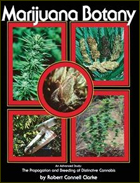
by Robert Connell Clarke
Senescence or Rejuvenation Stage
After a pistillate plant finishes floral maturation, the production of pistillate calyxes ceases and the plant continues senescence (decline towards death). In unusual situations, however, rejuvenation will begin and the plant will sprout new vegetative growth in preparation for the following season. Senescence is often highlighted by striking color changes in the floral clusters. Leaves, calyxes, and stems display auxiliary pigments ranging in color from yellow through red to deep purple. Eventually a brown shade predominates and death is near. In warm areas, rejuvenation starts as vegetative shoots form within the floral clusters. These shoots are usually made up of unserrated single leaflets separated by thin stems with long internodes. It is as if the plant were reaching for limited winter light. Leaf production is accelerated as plants reach the rejuvenation stage, and resin production completely stopped. Floral clusters left to ripen until the bitter end usually produce inferior marijuana of lowered THC level, especially out doors in bad weather.
Terpene secretion changes along with cannabinoid secretion and psychoactive effect. Various terpenes, terpene polymers, and other aromatic principles are produced and ripen at different times in the development of the plant. If these changes in aromatic principles are directly correlated with changes in cannabinoid production, then harvest selections for cannabinoid level may be possible based on the aroma of the ripening floral clusters. It is important to understand differences in the anatomy of floral clusters for each Cannabis strain. Trends in the relative quantity (dry weight) of various parts (such as leaves, calyxes and trichomes) at various harvest dates are characteristic of particular strains and may vary widely. Some generalizations can be made. In most cases, the percentage of stem weight steadily decreases as the floral cluster matures. Rejuvenation growth can account for a sudden increase in stem percentage. The percentage of inner leaves usually starts very low and climbs rapidly as the floral clusters mature. This often reflects increased leaf growth near the end of the season. In many strains the percentage of inner leaves drops sharply during the peak floral stage and rises again as calyx production slows and leaf production in creases in the late floral stage.
Calyx production follows two basic patterns. In one, the percentage of calyxes climbs gradually and levels out during the peak floral stage. It begins to decline in the late floral stage, and leaf production increases as calyx production ceases. Other strains continue to produce calyxes at the expense of leaves, and the calyx percentage increases steadily throughout maturation. In both cases, there is some tendency for calyx percentage to level out during the peak floral stage irrespective of whether leaf growth accelerates or calyx growth continues at a later stage. Resins generally accumulate steadily while the plant matures, but strains may vary as to the stage of peak resin secretion. Seed percentage increases exponentially with time if the crop is well fertilized, but most samples of Cannabis grown domestically are nearly seedless. To determine dry weight, samples are harvested, labeled, and air dried until the central stem of the floral cluster will snap when bent. In plant research, dry weight is done in ovens at higher temperatures, but these higher temperatures would ruin the Cannabis. The dry floral cluster is weighed. The outer leaves, inner leaves, calyxes, seeds, and stems are segregated and each group weighed individually. The percentage is determined by dividing the individual dry weights by the total dry weight.
Calyx percentage ranges from 30 to 70% of the dry weight of the seedless floral clusters, depending on variety and harvest date. Inner leaf percentages fluctuate between 15 and 45% of dry weight; stems range from 10 to 30%. It seems obvious that for marijuana harvesting a maximum calyx production is important to quality resin production. A strain where maximum calyx production occurs simultaneously with peak resin production is a breeding goal not yet attained. Harvesting Cannabis at the proper time requires information on how floral clusters mature and a decision on the part of the cultivator as to what type of floral clusters are desired. With harvesting as with other techniques of cultivation, the path to success is straightened when a definite goal is established. Personal preference is always the ultimate deciding factor.

